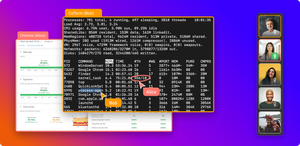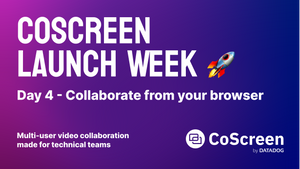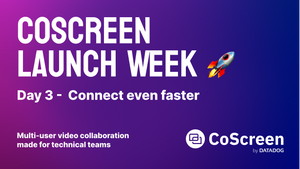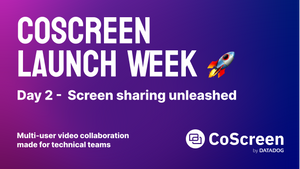Remote teams often struggle with frequent misunderstandings, breakdowns in communication, constant interruptions, and friction during handoffs between different team members.
Deep Collaboration addresses those issues through a highly-interactive, highly-focused approach for teams by empowering them to work intensively together on a joint project without distractions and artificial hurdles. It brings team members into a collective state of absolute focus and productivity flow.
The Deep Collaboration framework builds on the Deep Work concept by Cal Newport, associate professor in computer science at Georgetown University, and author of Deep Work: The Secret to Achieving Peak Productivity. Newport describes the ability to focus without distraction on a cognitively demanding task as such:
“To produce at your peak level you need to work for extended periods with full concentration on a single task free from distraction.”
Deep Collaboration takes this concept onto the team level. Teams work most productively when they adopt Deep Work for asynchronous workflows with easy or isolated tasks and Deep Collaboration for synchronous, complex matters. The latter can be solved best as a team if the team focuses intensively on removing any friction and distractions.
What defines a Deep Collaboration solution?
Deep Collaboration solutions are a type of software that enables teams to get things done together with minimal friction and with an absolute focus on a joint goal.
- Instant access: Contributors can join and contribute with minimal friction by accessing a unique invite link and often even without signing up.
Example: In Miro, team members can access shared whiteboards even without an account. - Real-time editing: Team members can see live what everyone is contributing to advance the project.
Example: In Figma, team members can see other collaborators’ mouse pointers and even follow along in real-time. - Multi-user editing: Team members can contribute simultaneously to achieve the best possible outcome together. Team members don't have to wait for their turn to do anything, unlike in presentation-focused solutions like Zoom or traditional file-based productivity solutions of the past.
Example: In CoScreen, anyone can share and edit any shared window using mouse and keyboard without having to ask for presenter rights or remote control permissions. - End-to-end workflows: Teams can use the Deep Collaboration solution to work holistically on an entire project, not just a small artifact.
Example: Design teams can work in Figma from early wireframes to hand-off the final design to development. Software engineering teams can develop an application using any IDE and CoScreen, all the way to deploying and monitoring it in production.
Examples of Deep Collaboration solutions
Figma, Miro, and CoScreen are great examples for products that have put deeply collaborative capabilities at the core of their user experience.
Figma enables Deep Collaboration for design teams
Figma is the archetype for Deep Collaboration solutions for design teams. Where users needed multiple tools in the past - one to create wireframes, a second one to turn them into high fidelity designs, and a third one to create an interactive screen flow - they now only need one.
"Figma is much more than a digital extension of our physical self—it’s an invitation to leave ego at the door and create shared consciousness with others."
- Dylan Field (CEO & Co-founder of Figma): Meet us in the browser
Miro enables Deep Collaboration for creative teams
Miro enables teams to collaborate from brainstorming and ideation to planning for execution via one, highly-interactive canvas and whiteboard. Similar apps are Mural and Lucidchart.
Notion enables Deep Collaboration for product teams
Notion has become incredibly popular with many teams because it allows easy, collaborative live editing of interactive documents and tables in a minimalistic UI. Similar apps are Roam Research, Coda, Airtable, or also the Google Workspace suite.
CoScreen enables Deep Collaboration for engineering & agile teams
CoScreen allows multiple team members to share and edit any application window simultaneously on a shared desktop, tying together the co-use of the other Deep Collaboration tools listed here. Engineering workflows are inherently cross-functional, and therefore engineering teams require a tool like CoScreen that enables them to collaborate across a multitude of project artifacts.
Via CoScreen, a designer might share an app design in Figma with a front-end engineer to tweak some labels together. A product manager might organize a review of a feature spec on a Jira Wiki with a team of engineers. A developer could implement an app’s component using Emacs while debugging with another developer using Visual Studio and seeing why an interface fails. They finally deploy it together using one user’s iTerm.
Deep Collaboration can also help the onboarding of new engineers, unblocking a crucial growth phase for teams. It fosters hands-on knowledge transfer, accelerates debugging complex issues and expensive outages together, and takes remote pair programming to a whole new level.
How Deep Collaboration improves teamwork
Deep Collaboration is a new type of teamwork where users can achieve a highly productive state together by reducing the artificial hurdles that prior solutions had put between them.
Before the rise of Deep Collaboration solutions, synchronous workflows were thought to have a negative cost factor in an increasingly distributed world. And yet, they remained a crucial part of the collaborative workflow of remote teams. Wade Foster, CEO of Zapier and an early remote-work pioneer, said the following at the Remote Stack Summit by Wing Venture Capital:
“We default to (the asynchronous approach) but recognize when synchronous needs to happen. It’s at those moments when it’s a meaty topic, and there’s nuance, and it’s not going to be straightforward.”
Remote teams should maximize the outcome of their limited synchronous time with each other through an intense focus to get the job done together.
The benefits of Deep Collaboration for remote teams
“One of the most exciting elements of successful Deep Collaboration companies is that they unlock substantive cross-functional collaboration because everyone can be close to the work itself.”
- Jake Saper (Emergence Capital): Salesforce + Slack mashup signals the rise of Deep Collaboration)
Deep Collaboration is a new way to work synchronously and unlocks the following benefits:
- Improving internal team alignment - by providing full transparency on the job to be done - for example, by enabling a view in real-time on a design project’s progress.
- Fostering cross-functional alignment - for example, by enabling a seamless handoff between remote design and engineering teams.
- Reducing friction in remote teams - because users can immediately contribute and help each other create better outcomes without any distractions.
- Increasing knowledge transfer in remote teams enables members to teach and learn from each other interactively and hands-on.
- Finally, Deep Collaboration leads to better results of remote teams because it enables the seamless combination of everyone’s skills for the common good.
Deep Collaboration improves the well-being and the productivity of remote teams dramatically and complements asynchronous workflows that have become increasingly popular while more and more organizations adopted remote working.
Learn more about Deep Collaboration
- Listen to the Deep Collaboration Podcast.
- Join the Deep Collaboration Community on Discord.
- Read the Deep Collaboration Manifesto for Engineering Teams.
- Deep Work at the MIT Sloan Management Review.






